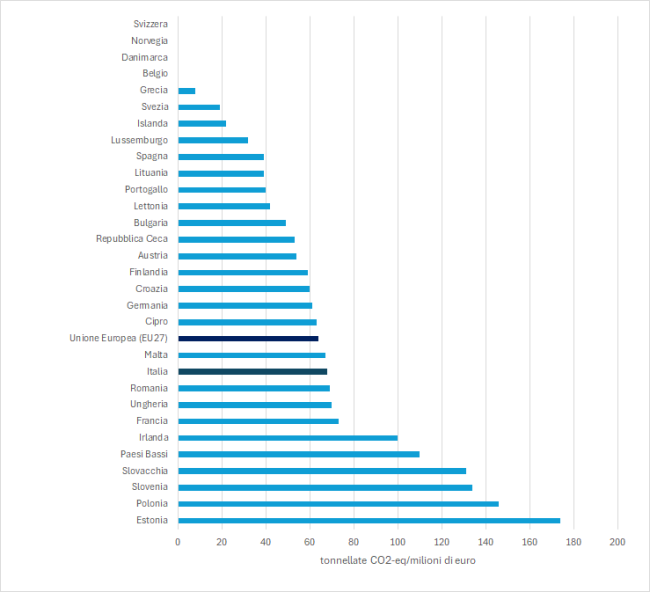Panel 1
Giovanni Finocchiaro, Silvia Iaccarino
During the pandemic years, 2020 and 2021, the Italian tourism sector experienced a drastic reduction in economic activity due to travel restrictions and virus containment measures. This contraction led to a significant decrease in the value added generated by the sector. However, CO₂ equivalent emissions did not decrease proportionally, as some sources of emissions—such as the maintenance of tourism infrastructure and indirect emissions related to the sector—remained relatively constant. As a result, emission intensity, measured in tonnes of CO₂ equivalent per million euros, increased during those years, as the same or similar quantities of emissions were associated with lower economic output.
In 2022, with the recovery of tourism activities and the increase in value added, emission intensity decreased significantly, falling below pandemic-period levels. This result reflects greater efficiency in the sector, where economic growth outpaced the increase in emissions. Nevertheless, Italy still ranks above the European average, indicating room for improvement in the environmental sustainability of tourism.
This indicator is part of the "green" pillar addressing environmental impacts in the European Union Tourism Dashboard. It measures the amount of greenhouse gas emissions produced by the tourism ecosystem per million euros of gross value added in the tourism sector.
The indicator includes the following greenhouse gases: CO₂, N₂O, CH₄, HFCs, PFCs, SF₆, and NF₃, all expressed in CO₂ equivalent. Lower values indicate a lower contribution to greenhouse gas emissions and air pollution per million euros of value added generated by the tourism ecosystem in a given destination.
The tourism activities that primarily contribute to greenhouse gas emissions include:
- Transport (air travel, road transport, and cruise ships)
- Hotels, resorts, and other accommodation facilities, which consume energy for heating, cooling, lighting, and other functions
- Recreational activities that require motorized vehicles, ski lifts, and skiing equipment, among others
To estimate the amount of greenhouse gas emissions attributable to the tourism ecosystem.
The indicator has no reference regulations or related targets.
Panel 2
Tourism GHG intensity - Green pillar - National | Indicator Map view (europa.eu)
Data quality assessment
EUROSTAT (Statistical Office of the European Communities)
Conti delle emissioni atmosferiche per attività NACE Rev. 2 (env_ac_ainah_r2)
https://ec.europa.eu/eurostat/web/products-datasets/-/env_ac_ainah_r2
Conti nazionali aggregati per branca di attività economica per attività NACE Rev. 2 (nama_10_A64)
https://ec.europa.eu/eurostat/web/products-datasets/-/nama_10_a64
Settori NACE a 2 cifre considerati: I55-I56, N79, R90-R92, R93 [ESTAT]
https://ec.europa.eu/eurostat/web/metadata/classifications
National
2019-2022
Indicator assessment
The indicator is obtained by dividing the amount of greenhouse gas emissions produced by tourism ecosystem activities by the gross value added in the tourism sector.
In 2022, Italy reduced the greenhouse gas emission intensity in tourism to 70.6 tonnes of CO₂ equivalent per million euros, compared to the higher values recorded in 2020 (116.9) and 2021 (101.9). This value signals a return to pre-pandemic levels but remains above the European Union average (51.4 t CO₂-eq/million euros), placing Italy among the countries with a relatively high environmental impact in the tourism sector (Table 1).
From 2019 to 2022, the trend in greenhouse gas emission intensity in tourism followed a curve characterized by a sharp increase during the pandemic years, followed by a decline in 2022. The peak in 2020–2021 was caused by the contraction of economic activity, while 2022 marks a recovery with greater efficiency. Despite this reduction, Italy remains above the EU average, suggesting the need for further sustainability policies in the tourism sector to reduce environmental impact over the medium to long term.
Data
Table 1: National distribution of greenhouse gas intensity in tourism
JRC, su dati Eurostat

The comparative analysis shows that in 2022, Italy (70.6 t CO₂-eq/million euros) was among the countries with emissions levels above the European average (51.4 t CO₂-eq/million euros), although it recorded a notable reduction compared to the pandemic years. Comparison with other countries highlights how tourism-based economies in Eastern Europe, such as Poland (163.1) and Romania (127.2), show higher values, while Western European countries such as Germany (36.3) and Spain (37.2) display lower levels. (Figure 1) This suggests that Italy likely needs to accelerate efforts to improve the environmental sustainability of tourism, investing in low-impact solutions and decarbonization strategies for the sector.